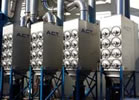One aspect of international travel that many people forget about is the importance of frequency converters. These seemingly less than convenient little items actually provide a much more important service than many know. This is because in the UK, like many other countries, outlets provide electricity at a voltage between 220 and 250 V while the main current in the United States operates in a range of 110 to 127 V. Although very necessary in using foreign appliances, converters and transformers are also commonly required for applications in the same country and even factory. This allows the optimal operation of several different machines and appliances, with several different electrical requirements, off of the same standardized power supply.
While the changes needed for global travel involve a difference in voltage, many power supply applications in the US and elsewhere require AC to DC converters or, though perhaps less common, power inverters, which reverse that equation. Both types of electrical current, AC and DC, involve the flow of electrons moving along a conductor in order to harness the energy. The difference is how those charges are moved. Direct current, DC power supplies surround wiring with a magnetic field that causes the electricity to flow in one direction as they are repelled and attracted by the poles of the magnet. AC power supplies create an alternating current by rotating the magnetic field. This means that the electrons move back and forth creating more sustainable electricity with less loss of energy.
Power supplies play an important role in the lives of most Americans. Even if the difference or engineering behind it is unclear, it is essential to know that the main power supply made available to homes, office and factories across the nation is an alternating current. The trouble is that many appliances, such as computers, camera chargers, heavy machinery and even telephone answering machines operate on DC currents. Luckily, rectifiers are now available for and even built in to many appliances to make conversion as simple for domestic applications as is the addition of an outlet adapter to protect devices used abroad. What’s more is that many of these converters also shield against unexpected surges or falls in electrical currents ensuring that the figurative and often literal melt-down so commonly experienced by travelers does not occur at home.
 Electric Coils
Electric Coils Electric Switches
Electric Switches Electric Transformers
Electric Transformers Electronic Connectors
Electronic Connectors Electronic Enclosures
Electronic Enclosures Membrane Switches
Membrane Switches Power Cords
Power Cords Power Supplies
Power Supplies Castings & Forgings
Castings & Forgings Bulk Material Handling
Bulk Material Handling Electrical & Electronic Components
Electrical & Electronic Components Flow Instrumentation
Flow Instrumentation Hardware
Hardware Material Handling Equipment
Material Handling Equipment Metal Cutting Services
Metal Cutting Services Metal Forming Services
Metal Forming Services Metal Suppliers
Metal Suppliers Motion Control Products
Motion Control Products Plant & Facility Equipment
Plant & Facility Equipment Plant & Facility Supplies
Plant & Facility Supplies Plastic Molding Processes
Plastic Molding Processes Pumps & Valves
Pumps & Valves Recycling Equipment
Recycling Equipment Rubber Products & Services
Rubber Products & Services